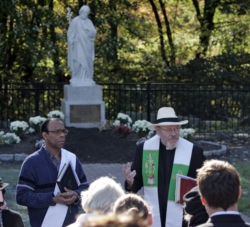Remains from rediscovered Roxbury cemetery reinterred
WALTHAM — A difficult chapter in the history of the archdiocese closed Oct. 21 at the reinterment ceremony at Waltham’s Calvary for the more than 1,200 unmarked remains discovered on the grounds of the closed St. Joseph Church in Roxbury.
Father Father Walter Waldron, pastor of Roxbury’s St. Patrick Church who was the pastor of St. Joseph Parish when it was closed concelebrated the reinterment rites with Bishop Walter James Edyvean, the leader of the archdiocese’s western region and Father Rodney J. Copp, the pastor of Waltham’s St. Charles Borromeo Church.
In his closing remarks, Father Waldron turned to Father Copp and said, “I just want to give him one charge: Take good care of them.”
The clerics were joined by descendents of members of St. Joseph’s, whose ancestors may be among the transferred remains and members of St. Patrick’s, the Roxbury parish the closed parish was folded into.
“I watched the work every day,” said Vi Robinson, a member of St. Patrick’s, whose home borders St. Joseph’s grounds.
Robinson said she would stand at her fence to watch the progress. “When they would find something they would get so excited. They would gather around it and then put it quickly into the box.”
Father Waldron said the Catholic Cemetery Association did a great job not only helping to coordinate the transfer of remains, but also in the establishment of the memorial park.
At the bottom of a slope that takes the eye up the rows of tombstones and into the heavens, the CCA erected a statue of St. Joseph from the original church. The bell stands 20 feet away.
Most of the individuals whose remains were buried at St. Joseph’s were from two counties in Ireland, Donegal and Roscommon, Father Waldron said. For this reason the rites took incorporated Celtic expressions of worship, such as the playing of Amazing Grace by bagpiper Dennis P. Delvin of the Bunker Hill Pipe Band in Charlestown and the recitation of The Lord’s Prayer in Gaelic.
On the statue’s plaque, he said he included a phrase in Gaelic that the workers found at many of the gravesites: “Ar dheis Dia go raibh n-anam.”
One of the archeologists told him the phrase is common in Irish cemeteries, he said. It translates into English as: “To the right hand of God their souls will sit.”



















